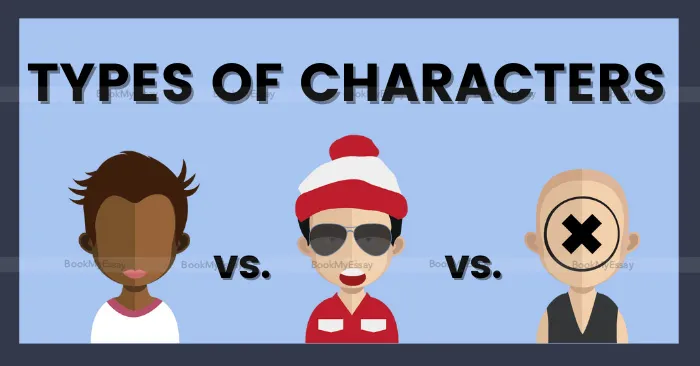Character Types In A Story
Character types in a story play a pivotal role in shaping the narrative and engaging the audience. Authors carefully craft characters to fulfill specific roles, enhancing the overall plot and thematic elements. Understanding the diverse spectrum of character types in a story is essential for both writers and readers alike.
The term "Types of Characters" encompasses a variety of roles, each serving a distinct purpose. Protagonists, often the central figures, drive the storyline forward and undergo significant development. Antagonists, on the other hand, create conflict and tension, providing challenges for the protagonists to overcome. Dynamic characters experience transformative journeys, evolving throughout the narrative, while static characters remain unchanged.
Supporting characters contribute depth and richness to the story, offering diverse perspectives and aiding in character development. Foils highlight specific traits in the main characters by providing a stark contrast. Complex characters possess multidimensional qualities, making them more realistic and relatable.
Exploring the nuances of character types in a story enhances storytelling, creating a dynamic and engaging literary experience for readers. By carefully choosing and developing characters, authors can effectively convey their themes and messages, leaving a lasting impact on the audience.
What Qualities Make A Protagonist In A Story Defining?
In the realm of story writing, crafting a compelling protagonist is paramount for a narrative's success. When tackling a story writing help, it becomes crucial to understand the defining qualities that make a protagonist stand out. The protagonist serves as the driving force, the character readers invest in emotionally, and their journey becomes the backbone of the narrative.
Several key qualities contribute to a protagonist's distinctiveness. Firstly, relatability is crucial – readers should connect with the protagonist on a personal level, fostering empathy and engagement. A well-rounded backstory and a blend of strengths and weaknesses add depth, making the protagonist dynamic and realistic. Additionally, the protagonist's motivation and goals create a sense of purpose, driving the narrative forward.
In the broader context of Types of Story Characters, the protagonist often falls into the category of the "hero" or "main character." Their evolution throughout the story, facing challenges and overcoming obstacles, shapes the narrative arc. Expertly weaving these elements together requires skill and creativity, making the protagonist a defining element in the art of storytelling. For students seeking story writing assignment help, understanding these qualities ensures a solid foundation for crafting compelling protagonists and captivating narratives.

What Sets An Antagonist Apart From Other Character Types In A Story?
In the realm of storytelling, the role of an antagonist is paramount, distinguishing itself through a nuanced portrayal that transcends mere opposition to the protagonist. When delving into character design, the Ultimate Guide on "How to Design a Character" becomes a crucial resource for writers seeking to craft compelling narratives. An antagonist, as illuminated by Assignment Writing Help Tutors, emerges as a character type with distinctive traits, motivations, and complex psychology. Unlike other characters, the antagonist embodies opposition, serving as a formidable force that challenges the protagonist's journey.
The Ultimate Guide emphasizes the significance of giving antagonists depth, motivations beyond mere villainy, and a believable backstory. This approach sets them apart, making them more than mere foils to the protagonist. Assignment Writing Help Tutors encourage writers to delve into the complexities of the antagonist's psyche, ensuring they resonate with readers. By following the principles outlined in "The Ultimate Guide How to Design a Character," writers can elevate their storytelling, creating antagonists that linger in the minds of audiences long after the story concludes.
How Are Characters Defined In BookMyEssay's Character Type Assignment?
BookMyEssay's Character Type Assignment Help in the UK goes beyond traditional academic support by offering a comprehensive approach to understanding and defining characters. When students seek assignment help online, they find a specialized service that delves into the intricacies of character development in literature. The platform not only assists in completing assignments but also enriches students' understanding of character types.
Characterization is explored in-depth, examining protagonists, antagonists, and supporting characters, ensuring a nuanced comprehension of their roles in a narrative. The UK-based assignment help service emphasizes the significance of character traits, motivations, and dynamics within a story. Through meticulous analysis and expert guidance, students gain insights into the complexities of character portrayal, enabling them to craft insightful assignments.
BookMyEssay's commitment to excellence in character-type assignments transcends conventional assistance, fostering a deeper appreciation for literary elements. With a focus on the UK academic landscape, the service aligns with curriculum requirements while offering a unique learning experience. As students engage with this assignment help platform, they not only meet academic expectations but also develop a refined understanding of character construction in literature.








 3 Bellbridge Dr, Hoppers Crossing, Melbourne VIC 3029
3 Bellbridge Dr, Hoppers Crossing, Melbourne VIC 3029



